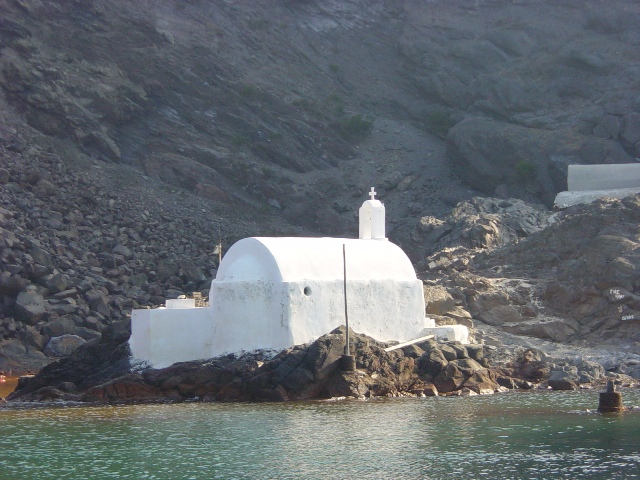
Saint Nikolas church and hot springs at Palea Kameni
According to Stravon, a new eruption occurred on the 145th Olympic Games, when Phillip V from Macedonia signed a peace agreement with the Romans. The eruption must have taken place in 197 BC and a new island appeared and it was named Iera (sacred) as people believed that it was created by a god.
A new eruption took place in 46 AD when the celebration of the 800th anniversary of the foundation of Rome started. It was then that a new island, known as Thea, emerged next to Iera and between Thera and Therasia. The volcano seems to be silent during the next 700 years or at least there are no scripts referring to eruptions for that era.
The volcano woke up again in 726 AD when a new strong eruption occurred. A new island was then created to the north of Iera. Later, these two islands were united and formed Palea Kameni. This was such a strong eruption that the pumice produced, covered the sea surface reaching the north coasts of Greece as well as Asia Minor coasts. This eruption had a great impact on the development of the west civilization.
The creation of Iera and Palea Kameni
According to Stravon, a new eruption occurred on the 145th Olympic Games, when Phillip V from Macedonia signed a peace agreement with the Romans. The eruption must have taken place in 197 BC and a new island appeared and it was named Iera (sacred) as people believed that it was created by a god. A new eruption took place in 46 AD when the celebration of the 800th anniversary of the foundation of Rome started. It was then that a new island, known as Thea, emerged next to Iera and between Thera and Therasia. The volcano seems to be silent during the next 700 years or at least there are no scripts referring to eruptions for that era. Howver it woke up in 726 AD when a new strong eruption occurred. A new island was then created to the north of Iera. Later, these two islands were united and formed Palea Kameni. This was such a strong eruption that the pumice produced, covered the sea surface reaching the north coasts of Greece as well as Asia Minor coasts. This eruption had a great impact on the development of the west civilization.
